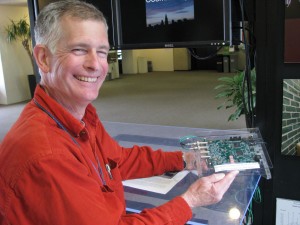One month ago, Fermilab's Bob Peterson embarked on a month-long journey in the Atlantic Ocean with two cosmic ray muon detectors, collecting data for science and education programs. This offers a chance to study how cosmic ray recordings differ on land and sea and at different latitudes. The data will be accessible to high school students and teachers in several countries who use similar detectors to learn about particle physics. Bob recorded the entire adventure, which concluded last week, in Quantum Diaries. He posted the following entry on May 12, just as his ship was about to pass the equator.
Enduring a branding for QuarkNet science education
4 May 2011
R/V Polarstern
Latitude: 9-47.1 N
Longitude: 19-46.2 W
off the coast of Guinea
Ship course 320 ° T
Ship velocity 10.1 knots
4 May 2011:
Two days ago, the R/V Polarstern stopped mid-ocean at latitude: 00-00.053S, longitude: 11-39.259W.
By my reckoning, that’s 318 feet south of that east-west line “painted” in the water. Guilty parties were forced into very little rubber rafts and pointed in obscure directions and told to “cross the line”. Only one actually knew which way to go. After circular paddling, which amounted to three times the distance required to cross the line, those guilty of being equator-crossing newbies were initiated as shellbacks .
And what an initiation it was.
Neptune, lord of the sea, and his court rose up out of the Atlantic for the ritual baptism of those who had violated his domain. A trial was held and renaming of the pollywogs was required. Much fun and antics was had by the entire crew as they put on a real show of cruel and dastardly deeds. I could almost hear them cackling like the pirates of days past: “Arrrghhh! Avast ye maties!”
Bathing in stinky slop ensued, ceremonial memorizing of creeds was demanded and kissing of the feet of Neptune’s wives was enjoyed. Men in drag wearing clown shoes slathered in mustard and horseradish sauce stood in for Neptune’s wives. Lovely. I was also assisted by large, burly men with tattoos into a baptismal font made from a large fish basket. Four times I went in it; I must have been extra sinful. Each dunking got nastier as more people were “baptized”.
Finally they branded our stomachs with Neptune’s trident. This was a bit scary because they covered our faces with hoods execution-style and we could hear the metal trident heating in a charcoal grill and sizzling as it pressed onto flesh. Thankfully, when it came to my turn I found out the sizzle was the trident branding a raw piece of meat that then got slapped onto my stomach. The crew got a great laugh out of our initiation.
We earned certificates for our ceremonial passage and a feast at sunset. Neptune felt the ceremony was befitting and left without taking the ship with him. So I am now the shellback known as Cosmic-Ray Rider, and I have pictures and a certificate to prove it.
Those will have to do because I skipped one of the most permanent parts of the ceremony. While I appreciate all the suggestions of earring types from friends and family, I decided to forego that little ritual. It’s the burly men that punch the hole, and they’re none too delicate.
So, the cosmic ray muon detector gave me my shellback name, but it’s also been my source of grief. Sometimes delicate instruments refuse to cooperate. For me, the trouble has been channel four and a scintillator counter that drops off line. Of course, it’s the one on the bottom of the stack, and it chooses to act up in the middle of the night. Several times in the morning I find it asleep, and that no data was taken during the night. Suspecting a light leak, I rewrapped it twice. Nope; that’s not it. Then I discover a flakey wire into the photo multiplier tube. There must be a short inside that photo multiplier tube. To compensate, I have lowered the coincidence to 3-fold from four so that a particle signal recorded in the three working sections of the detector will count as cosmic ray remnant event. Now, I will at least get some data. A replacement wire is some 8,000 miles away at Fermilab and the parts you can find along our route are pretty wet wheeling, as they say.
After many days in the southeast trade winds, we pushed through the doldrums, an area of still air near the equator that seems to rise rather than blow, and into the northeast trade winds. Other than the stop for the equator crossing, our course and speed have been relentless: 320 ° T, 11 knots; however, the following winds and swell have now turned on the nose and have become quite lumpy. Max, the weather guesser, promises it will get worse. In several days we make a turn to the north and a planned stop at the Canary Islands to pick more scientists.
Glossary:
*Pollywog: Some no good, inexperienced mariner who has never crossed the equator.
*Shellback: The opposite of a pollywog.
*Coincidences: The cosmic ray muon detector looks for what we call coincidences, two signals, one from each photo multiplier tubes, received within a short time. These are reported to the computer; all other signals are vetoed as likely background noise from the photo multiplier tubes.







